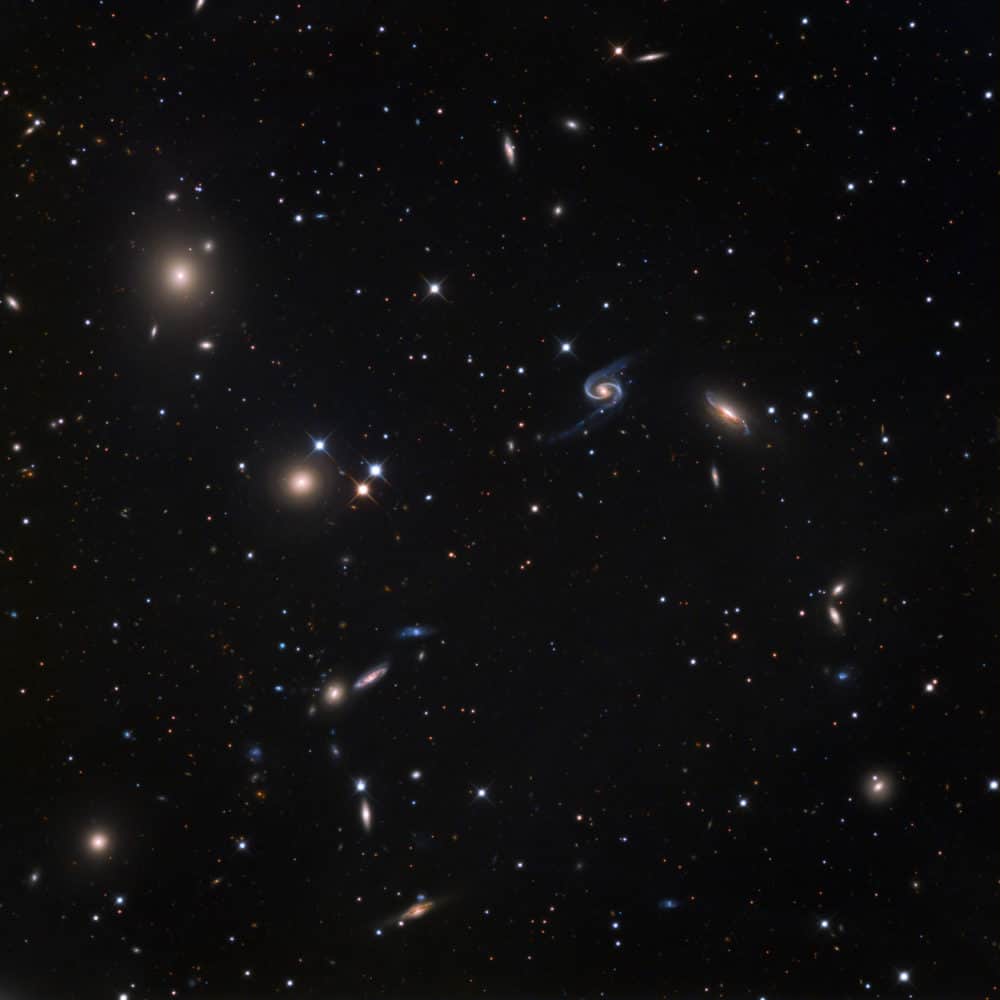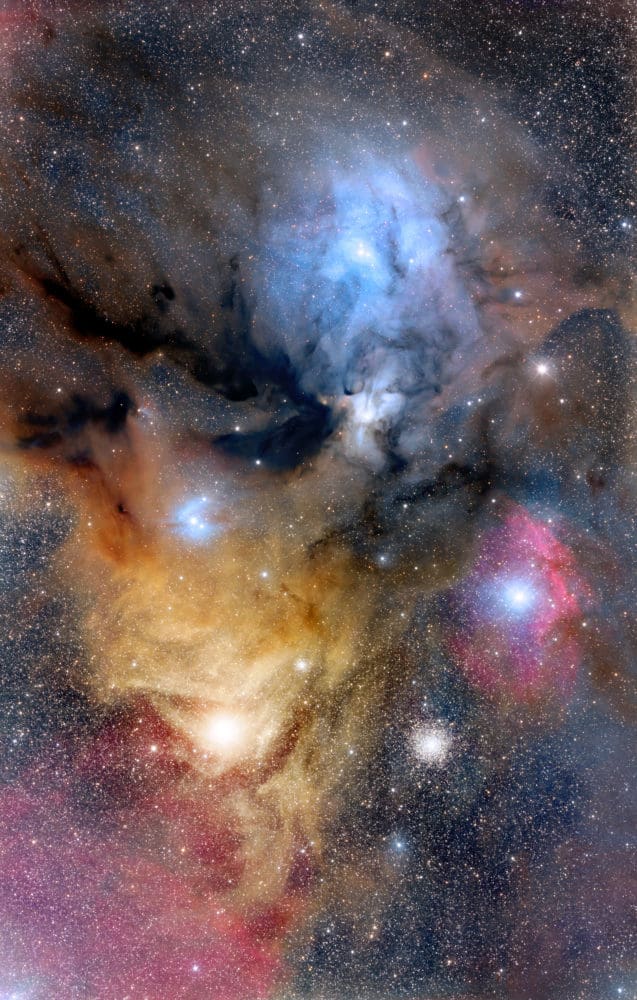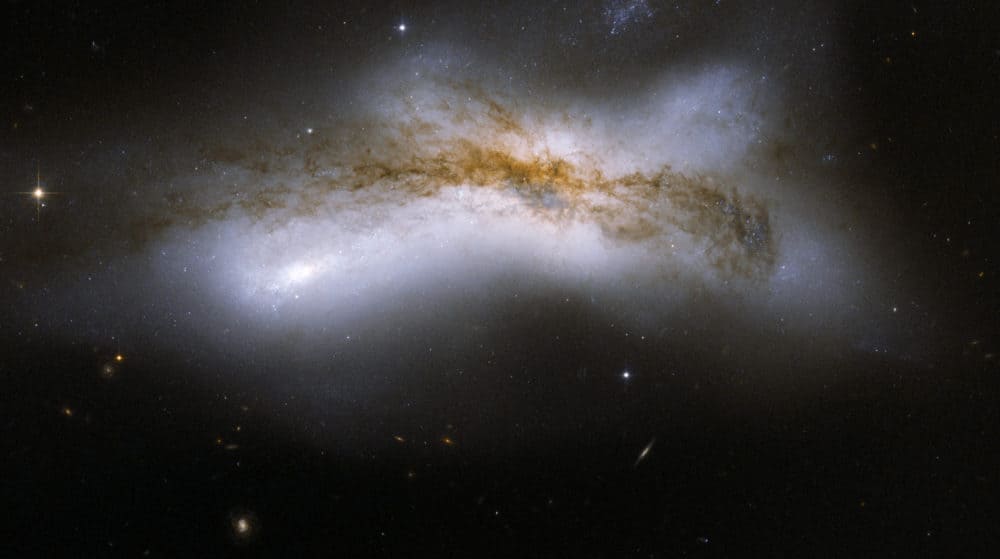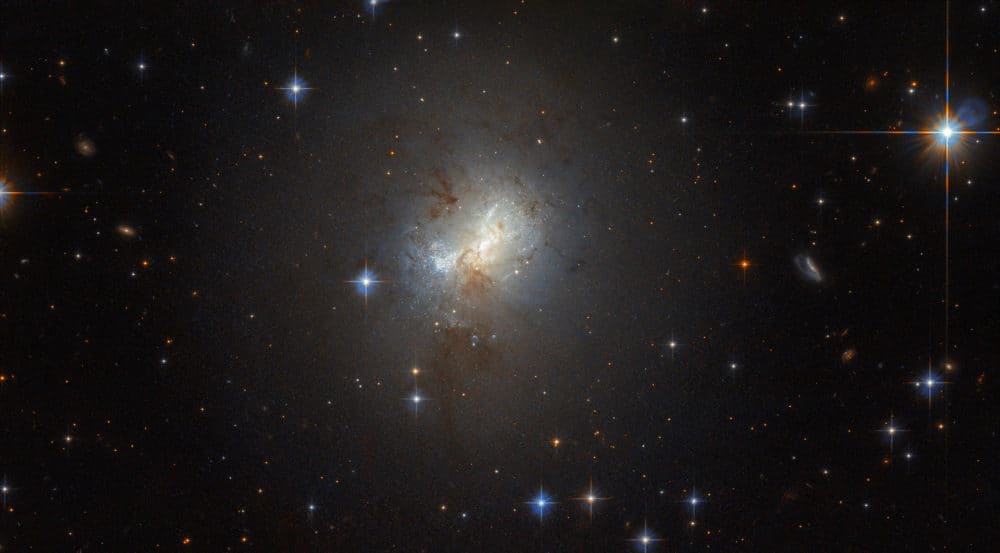Blog
NGC 90 is an interacting spiral galaxy estimated to be about 300 million light-years away in the constellation of Andromeda. It was discovered by R. J. Mitchell in 1854 and its apparent magnitude is 13.7. The galaxy is currently interacting with NGC 93 and exhibits two highly elongated and distorted spiral arms with bright blue star clusters indicative of star formation, likely caused by the interaction with its neighbor.
NGC 90 and NGC 93 form the interacting galaxy pair Arp 65.
more...
Jai Johanny Johanson (born July 8, 1944), frequently known by the stage name Jaimoe, is an American drummer and percussionist. He is best known as one of the founding members of The Allman Brothers Band. Johanson came up in the R&B world and began drumming at an early age, often accompanied by friend Lamar Williams on bass. Johanson backed soul singers, including a membership in Otis Redding‘s touring band in 1966, and afterward touring with the acclaimed soul duo, Sam & Dave. After joining up with Duane Allman in February 1969, he quickly became the first recruit into Allman’s new group, soon joined by bassist Berry Oakley, fellow drummer Butch Trucks, guitarist Dickey Betts and lastly Allman’s younger brother, singer, organist and pianist Gregg Allman. The group, quickly named after the brothers Allman, began recording demos that April in Macon, Georgia, which became the group’s home base.
more...Johnnie Clyde Johnson (July 8, 1924 – April 13, 2005) was an American pianist who played jazz, blues and rock and roll. His work with Chuck Berry led to his induction into the Rock and Roll Hall of Fame. He was posthumously awarded the Congressional Gold Medal for breaking racial barriers in the military, as he was a Montford Point Marine – where the African-American unit endured racism and inspired social change while integrating the previously all-white Marine Corps during World War II. Johnson was born in Fairmont, West Virginia. He began playing the piano in 1928. He joined the United States Marine Corps during World War II and became a member of Bobby Troup‘s all-serviceman jazz orchestra, the Barracudas. After his service, he moved to Detroit, Illinois and then Chicago, where he sat in with many notable artists, including Muddy Waters and Little Walter.
He moved to St. Louis, Missouri, in 1952 and immediately assembled a jazz and blues group, the Sir John Trio, with the drummer Ebby Hardy and the saxophonist Alvin Bennett. The three had a regular engagement at the Cosmopolitan Club, in East St. Louis. On New Year’s Eve 1952, Bennett had a stroke and could not perform. Johnson, searching for a last-minute replacement, called a young man named Chuck Berry, the only musician Johnson knew who, because of his inexperience, would likely not be playing on New Year’s Eve. Although then a limited guitarist, Berry added vocals and showmanship to the group. Bennett was not able to play after his stroke, so Johnson hired Berry as a permanent member of the trio.
Berry took one of their tunes, a reworking of Bob Wills‘s version of “Ida Red“, to Chess Records in 1955. The Chess brothers liked the song, and soon the trio were in Chicago recording “Maybellene” and “Wee Wee Hours” – a song Johnson had been playing as an instrumental for years, for which Berry quickly wrote some lyrics. “Maybellene” got Berry and Johnson onto the Billboard charts in 1955. Berry got signed as a solo act, and Johnson and Hardy became part of Berry’s band. Said Johnson, “I figured we could get better jobs with Chuck running the band. He had a car and rubber wheels beat rubber heels any day.”
Over the next 20 years, the two collaborated on many of Berry’s songs, including “School Days“, “Roll Over Beethoven“, “Carol“, and “Nadine“. The song “Johnny B. Goode” was reportedly a tribute to Johnson, with the title referring to Johnson’s behavior when he was drinking.
more...
Louis Thomas Jordan (July 8, 1908 – February 4, 1975) was an American musician, songwriter and bandleader who was popular from the late 1930s to the early 1950s. Known as “The King of the Jukebox“, his highest profile came towards the end of the swing era.
Jordan was a talented singer with great comedic flair, and he fronted his own band for more than twenty years. He duetted with some of the biggest solo singing stars of his time, including Bing Crosby, Ella Fitzgerald and Louis Armstrong. Jordan was also an actor and a film personality—he appeared in dozens of “soundies” (promotional film clips), made numerous cameos in mainstream features and short films, and starred in two musical feature films made especially for him. He was an instrumentalist who played all forms of the saxophone but specialized in the alto. He also played the piano and clarinet. A productive songwriter, he wrote or co-wrote many songs that were influential classics of 20th-century popular music.
Jordan began his career in big-band swing jazz in the 1930s, but he became known as one of the leading practitioners, innovators and popularizers of jump blues, a swinging, up-tempo, dance-oriented hybrid of jazz, blues and boogie-woogie. Typically performed by smaller bands consisting of five or six players, jump music featured shouted, highly syncopated vocals and earthy, comedic lyrics on contemporary urban themes. It strongly emphasized the rhythm section of piano, bass and drums; after the mid-1940s, this mix was often augmented by electric guitar. Jordan’s band also pioneered the use of the electronic organ.
With his dynamic Tympany Five bands, Jordan mapped out the main parameters of the classic R&B, urban blues and early rock-and-roll genres with a series of highly influential 78-rpm discs released by Decca Records. These recordings presaged many of the styles of black popular music of the late 1940s, 1950s and 1960s and exerted a strong influence on many leading performers in these genres. Many of his records were produced by Milt Gabler, who went on to refine and develop the qualities of Jordan’s recordings in his later production work with Bill Haley, including “Rock Around the Clock“.
Jordan ranks fifth in the list of the most successful African-American recording artists according to Joel Whitburn‘s analysis of Billboard magazine’s R&B chart. Though comprehensive sales figures are not available, he had at least four million-selling hits during his career. Jordan regularly topped the R&B “race” charts and was one of the first black recording artists to achieve significant crossover in popularity with the mainstream (predominantly white) American audience, having simultaneous Top Ten hits on the pop charts on several occasions.
more...https://www.youtube.com/watch?v=1YPhyHRCqyQ&list=PLEB3LPVcGcWZ0hsQ5_jgSMhawAnDzy1io&index=2&t=84s
more...Featuring the bright, red supergiant star Antares, the Rho Ophiuchi cloud complex is one of the most vibrant and colorful nebulas in space and the closest star-forming region to the solar system.
Located approximately 460 light-years away from Earth, the interstellar clouds of gas and dust that make up Rho Ophiuchi contain emission nebulas that are rich with red, glowing hydrogen gas and blue reflection nebulas that reflect starlight from their surroundings. The dark-brown regions in the cloud complex consist of interstellar dust grains that prevent any light from passing through.
more...Sir Richard Starkey (born 7 July 1940), known professionally as Ringo Starr, is an English musician, singer, songwriter and actor who gained worldwide fame as the drummer for the Beatles. He occasionally sang lead vocals with the group, usually for one song on each album, including “With a Little Help from My Friends“, “Yellow Submarine“, “Good Night“, and their cover of “Act Naturally“. He also wrote and sang the Beatles’ songs “Don’t Pass Me By” and “Octopus’s Garden“, and is credited as a co-writer of others, including “What Goes On” and “Flying“.
Starr was afflicted by life-threatening illnesses during childhood, and he fell behind in school as a result of prolonged hospitalisations. He briefly held a position with British Rail before securing an apprenticeship at a Liverpool equipment manufacturer. Soon afterwards, he became interested in the UK skiffle craze and developed a fervent admiration for the genre. In 1957, he co-founded his first band, the Eddie Clayton Skiffle Group, which earned several prestigious local bookings before the fad succumbed to American rock and roll by early 1958. When the Beatles formed in 1960, Starr was a member of another Liverpool group, Rory Storm and the Hurricanes. After achieving moderate success in the UK and Hamburg, he quit the Hurricanes and joined the Beatles in August 1962, replacing Pete Best.
Starr played key roles in the Beatles’ films and appeared in numerous others. After the band’s break-up in 1970, he released several successful singles including the US number-four hit “It Don’t Come Easy“, and number ones “Photograph” and “You’re Sixteen“. In 1972, he released his most successful UK single, “Back Off Boogaloo“, which peaked at number two. He achieved commercial and critical success with his 1973 album Ringo, which was a top-ten release in both the UK and the US. He has featured in a number of documentaries and hosted television shows. He also narrated the first two series of the children’s television programme Thomas & Friends and portrayed “Mr Conductor” during the first season of the PBSchildren’s television series Shining Time Station. Since 1989, he has toured with thirteen variations of Ringo Starr & His All-Starr Band.
more...Josef Erich Zawinul (7 July 1932 – 11 September 2007) was an Austrian jazz keyboardist and composer. First coming to prominence with saxophonist Cannonball Adderley, Zawinul went on to play with Miles Davis and to become one of the creators of jazz fusion, a musical genre that combined jazz with rock. He co-founded the groups Weather Report and The Zawinul Syndicate. He pioneered the use of electric piano and synthesizer, and was named “Best Electric Keyboardist” twenty-eight times by the readers of Down Beat magazine.
Zawinul grew up in Vienna, Austria. Accordion was his first instrument. When he was six or seven, he studied clarinet, violin, and piano at the Vienna Conservatory (Konservatorium Wien). During the 1950s he was a staff pianist for Polydor. He worked as a jazz musician with Hans Koller, Friedrich Gulda, Karl Drewo, and Fatty George. In 1959 he moved to the U.S. to attend Berklee College of Music, but a week later he received a job offer from Maynard Ferguson, so he left school and went on tour. He then accompanied Dinah Washington. He spent most of the 1960s with Cannonball Adderley. During this time he wrote “Mercy, Mercy, Mercy” and “Walk Tall”, and “Country Preacher” and played electric piano. At the end of the decade he recorded with Miles Davis on In a Silent Way as Davis was establishing the genre of jazz fusion, combining jazz with rock.
more...Henry “Hank” Mobley (July 7, 1930 – May 30, 1986) was an American hard bop and soul jazz tenor saxophonist and composer. Mobley was described by Leonard Feather as the “middleweight champion of the tenor saxophone”, a metaphor used to describe his tone, that was neither as aggressive as John Coltrane nor as mellow as Stan Getz, and his style that was laid-back, subtle and melodic, especially in contrast with players like Sonny Rollins and Coltrane. The critic Stacia Proefrock claimed he is “one of the most underrated musicians of the bop era.” Mobley was born in Eastman, Georgia, but was raised in Elizabeth, New Jersey, near Newark. When he was 16, an illness kept him in the house for several months. His grandmother thought of buying a saxophone to help him occupy his time, and it was then that Mobley began to play. He tried to enter a music school in Newark, but could not, since he was not a resident, so he instead studied music through books at home.
At 19, he started to play with local bands and, months later, worked for the first time with musicians like Dizzy Gillespie and Max Roach. He took part in one of the earliest hard bop sessions, alongside Art Blakey, Horace Silver, Doug Watkins and trumpeter Kenny Dorham. The results of these sessions were released as Horace Silver and the Jazz Messengers. They contrasted with the classical inclinations of cool jazz, with Mobley’s rich lyricism being bluesier, alongside the funky approach of Silver. When The Jazz Messengers split in 1956, Mobley continued on with pianist Silver for a short time, although he did work again with Blakey some years later, when the drummer appeared on Mobley’s albums in the early 1960s.
more...Lloyd “Tiny” Grimes (July 7, 1916 – March 4, 1989) was an American jazz and R&B guitarist. He was a member of the Art Tatum Trio from 1943 to 1944, was a backing musician on recording sessions, and later led his own bands, including a recording session with Charlie Parker. He is notable for playing the tenor guitar, a four-stringed electric instrument. Grimes was born in Newport News, Virginia, United States, and began his musical career playing drums and one-fingered piano. In 1938 he took up the electric four-string tenor guitar. In 1940 he joined the Cats and the Fiddle as guitarist and singer. In 1943 he joined the Art Tatum Trio as guitarist and made a number of recordings with Tatum.
After leaving Tatum, Grimes recorded with his own groups in New York and with a long list of leading musicians, including vocalist Billie Holiday. He made four recordings with his own group, augmented with Charlie Parker: “Tiny’s Tempo”, “Red Cross”, “Romance Without Finance”, and “I’ll Always Love You Just the Same”, the latter two featuring Grimes’ singing.
In the late 1940s, he had a hit on a jazzed-up version of “Loch Lomond“, with the band billed as Tiny “Mac” Grimes and the Rocking Highlandersand appearing in kilts. This groups included tenor saxman Red Prysock and singer Screaming Jay Hawkins. Grimes continued to lead his own groups into the later 1970s and he recorded on Prestige Records in a series of strong blues-based performances with Coleman Hawkins, Illinois Jacquet, Pepper Adams, Roy Eldridge and other noted players including, in 1977, Earl Hines.
https://www.youtube.com/watch?v=V8B900gBv9Q
more...NGC 520 is a pair of colliding spiral galaxies about 78 million light-years away in the constellationPisces and were discovered by astronomer William Herschel on 13 December 1784. The object has an H II nucleus.
NGC 520 is the product of a collision between two disk galaxies that started 300 million years ago. It exemplifies the middle stages of the merging process: the disks of the parent galaxies have merged together, but the nuclei have not yet coalesced. It features an odd-looking tail of stars and a prominent dust lane that runs diagonally across the center of the image and obscures the galaxy. NGC 520 is one of the brightest galaxy pairs on the sky, and can be observed with a small telescope toward the constellation of Pisces, the Fish, having the appearance of a comet. It is about 100 million light-years away and about 100,000 light-years across. The galaxy pair is included in Arp’s catalog of peculiar galaxies as Arp 157. This image is part of a large collection of 59 images of merging galaxies taken by the Hubble Space Telescope and released on the occasion of its 18th anniversary on 24th April 2008. About the object Object name NGC 520, Arp 157, VV 231, KPG 031 Object description Interacting Galaxies Position (J2000) 01 24 35.42 +03 47 55.0 Constellation Pisces Distance 100 million light-years (50 million parsecs).
more...
Michael Shrieve (born July 6, 1949) is an American drummer, percussionist, and composer. He is best known as the drummer of the rock band Santana. He played on its albums from 1969 to 1974. Shrieve was one of the youngest musicians to perform at Woodstock in 1969, being aged 20. His drum solo during “Soul Sacrifice” in the Woodstock film has been described as “electrifying”. Shrieve’s first full-time band was called Glass Menagerie, followed by experience in the house band of an R&B club, backing touring musicians including B.B. King and Etta James. At 16, Shrieve played in a jam session at the Fillmore Auditorium, where he attracted the attention of Santana‘s manager, Stan Marcum. When he was 19, Shrieve jammed with Santana at a recording studio and was invited to join that day.
https://www.youtube.com/watch?v=AqZceAQSJvc
more...Gene Chandler (born Eugene Drake Dixon and nicknamed “The Duke of Earl” or simply “The Duke”; July 6, 1937) is an American singer, songwriter, music producer and record label executive. He is known best for his most successful songs “Duke of Earl” and “Groovy Situation” and his association with The Dukays, the Impressions and Curtis Mayfield.
Chandler is a Grammy Hall Of Fame inductee and a winner of both the National Association of Television and Radio Announcers’ (NATRA) “Producer of the Year” Award and the Rhythm and Blues Foundation‘s Pioneer Award. He is also one of a just a few singers to achieve chart successes spanning the doo-wop, rhythm and blues, soul, and disco musical eras, with some Top 40 pop and R&B chart hits between 1961 and 1986. Chandler was inducted as a performer into the Rhythm and Blues Music Hall of Fame on August 24, 2014. In 2016, he became a “Double Inductee” into the R&B Hall of Fame, having received a Special Induction as an R&B Music Pioneer.
Gene Chandler was born Eugene Drake Dixon in Chicago, Illinois, on July 6, 1937. He attended Englewood High School on Chicago’s south side. He began performing during the early 1950s with the band The Gaytones. In 1957, he joined The Dukays, with James Lowe, Shirley Jones, Earl Edwards and Ben Broyles, soon becoming their lead singer. After his draft into the U.S. Army he returned to Chicago in 1960 and rejoined the Dukays.
more...Luigi Paulino Alfredo Francesco Antonio Balassoni (July 6, 1924 – February 14, 2009), known by the stage name Louie Bellson (his own preferred spelling, although he is often seen in sources as Louis Bellson), was an American jazz drummer. He was a composer, arranger, bandleader, and jazz educator, and is credited with pioneering the use of two bass drums.
Bellson was an internationally acclaimed artist who performed in most of the major capitals around the world. Bellson and his wife, actress and singer Pearl Bailey (married from 1952 until Bailey’s death in 1990), had the second highest number of appearances at the White House (only Bob Hopehad more).
Bellson was a vice president at Remo, a drum company. He was inducted into the Modern Drummer Hall of Fame in 1985. Bellson was born in Rock Falls, Illinois in 1924, where his father owned a music store. He started playing drums at three years of age. While still a young child, Bellson’s father moved the family and music store to Moline, Illinois . At 15, he pioneered using two bass drums at the same time, a technique he invented in his high school art class. At age 17, he triumphed over 40,000 drummers to win the Slingerland National Gene Krupa contest.
After graduating from Moline High School in 1942, he worked with big bands throughout the 1940s, with Benny Goodman, Tommy Dorsey, Harry James, and Duke Ellington. In 1952, he married jazz singer Pearl Bailey. During the 1950s, he played with the Dorsey Brothers, Jazz at the Philharmonic, acted as Bailey’s music director, and recorded as a leader for Norgran Records and Verve Records.
Over the years, his sidemen included Ray Brown, Pete and Conte Candoli, Chuck Findley, John Heard, Roger Ingram, Don Menza, Blue Mitchell, Larry Novak, Nat Pierce, Frank Rosolino, Bobby Shew, Clark Terry, and Snooky Young.
more...https://www.youtube.com/watch?v=fdRQT-OVxZE
more...https://www.youtube.com/watch?v=lZ5Jd1na5Eo&list=PLEB3LPVcGcWZ0hsQ5_jgSMhawAnDzy1io&index=4&t=0s
more...ESO 495-21 is located approximately 30 million light-years away in the constellation of Pyxis.
Also known as Henize 2-10 or LEDA 24171, it is a dwarf starburst galaxy — this means that it is small in size, but ablaze with rapid bursts of star formation.
Starburst galaxies form stars at exceptionally high rates, creating stellar newborns of up to 1,000 times faster than our own Milky Way Galaxy.
ESO 495-21 is only 3% the size of the Milky Way, and yet there are indicationsthat the black hole at its core is over a million times as massive as the Sun — an extremely unusual scenario.
This black hole may offer clues as to how black holes and galaxies evolved in the early Universe.
The origin of the central supermassive black holes in galaxies is still a matter of debate.
Do the galaxies form first and then crush material at their centers into black holes, or do pre-existing black holes gather galaxies around them?
Do they evolve together — or could the answer be something else entirely?
With its small size, indistinct shape, and rapid starburst activity, astronomers think ESO 495-21 may be an analogue for some of the Universe’s first galaxies.
Finding a black hole at ESO 495-21’s heart is therefore a strong indication that black holes may have formed first, with galaxies later developing and evolving around them.
more...More Posts
- Hubert Laws
- Paul Bley
- Carl W Stalling
- World Music with Elida Almeida
- Daily Roots with Desmond Dekker
- Surviving the Pandemic and Realizing Racial Justice
- The Cosmos with Aurora over Norway
- Mary Travers
- Lynn Baker
- Mezz Mezzrow
- World Music with Cándido Camero Memorial
- Daily Roots with the Mighty Diamonds
- Surviving the Pandemic and Realizing Racial Justice
- The Cosmos with IC 1727
- Bonnie Raitt
- Minnie Riperton
- Dale Bruning
- Kenny Cox
- Warren Battiste
- World Music with Sauljaljui



